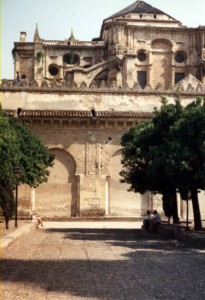
The ancient building at the heart of Cordova’s old quarter breathed quiet, and the cool dimness of an old-growth forest, that kind of forest where the straight trunks of ancient trees spring from the leaf-mast, moss or bracken fronds at their feet. There is no intermediate brush, no smaller trees clogging the sightlines between the tree trunks, which go on forever in every direction. Shafts of sunshine sometimes find a break in the green canopy overhead, and in the morning, wisps of fog tangle around the tree-trunks like tatters of silk scarf. But there was no early morning fog here, no bracken or grass at our feet, only the ancient floor paving, undulating slightly with twelve hundred years of wear and settlement.
My daughter and I blinked, coming in from the dazzle outside— pillared groves of orange trees in the courtyard outside, under a brilliant blue sky, magenta bougainvillea flaming against whitewash and the rose-honey color of weathered terracotta tiles.
It was like a forest, a forest of stone columns in every direction, a forest of columns holding up an endless series of horseshoe arches striped in rust and cream-color, a maze without walls that went on and on, and on – at least until one got to the ungainly cathedral plunked into the very center of it, like a horsefly imbedded in a perfect piece of amber. The monarch who had bidden it to be built was said to have chided the architects afterwards, saying “You have built here what can be built anywhere else, but you have destroyed what was unique in the world.”
The great mosque of Cordova had this in common with other venerable ecclesiastical structures — so large as to be able to absorb great numbers of people, yet still seem hushed, near to empty, as if to raise a loud voice or to make any sort of noise would be a sacrilege. It was holy, beautiful, and alien – the high-water mark of Moorish Spain, the third largest mosque in the world. It was built in the 8th century, when Cordova was probably the most urbane, cultured and tolerant city in Western Europe, all the markings of high civilization as we know it – although given the standard of sanitation, literacy and religious toleration prevalent elsewhere in Europe, not a hard mark to surpass. The Cordova Caliphate soon disintegrated into warring mini-states, and the Reconquista painfully and over six centuries clawed back every kingdom, city, and acre. The Moors vanished from Spain like mist in the morning, leaving their marvelous palaces, mosques and cities behind, adorned with jeweled tiles, intricate plasterwork, and cool water fountains; marvelous buildings that set the architectural tone of Spain and by extension, the Spanish Colonial and Beaux-Arts buildings run up by the homesick or nostalgic in the Southwestern United States.
Plaster walls, colonnades overgrown with brilliant bougainvillea, horseshoe arches, and geometric tile, terracotta tiles and orange trees, distilled over centuries into something worn and familiar, something I know as well as the street I live on – but at the core of it, that alien, hostile something, the niggling worm of militant Islam. They would have Al-Andalus back, and rip out that silly, ill-considered cathedral, take back all that was lost. And more. Or so they say, if you take them at their word.
(This is an archive post for your delectation from away back in the distant mists of the ncobrief.com. Also – because I have a good stock of my own books at present – as one of the Christmas events that I had meant to sell them at was cancelled and another was a complete bust to due to very cold weather – I am having a Christmas sale today through the 19th. All my books sold through my book website are marked down 15%, and there is a special deal for all three books of the Trilogy, plus Daughter of Texas and Deep in the Heart for $50. Orders made this weekend have a good chance of arriving by Christmas.)
Once upon a time I thought that cathedral was ridiculous, too. But now I kind of like it. The Moors thought they had crushed and eradicated the civilization, religion, and culture of the people they had conquered. But they came back, acre by acre, all fighting by hand with cold steel. It will take six hundred years? Muy bien. Bring it on. That cathedral in the mosque is like a big Fuck You to the Conquista. As a symbol of impossibly stubborn perseverance, I like it.
Alas, the Moors are trying to take it back. Guess we’ll just have to see how it all plays out.
Yeah. The future belongs to those who show up. The Spanish aren’t having kids, and the ones they do have are all in London trying to grab the last Starbucks barista job.
Of course fertility is collapsing in much of the Muslim world as well. We’ll see.